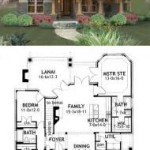Stock house plans are pre-designed architectural blueprints that provide a framework for constructing a home. They offer a cost-effective and practical alternative to custom-designed plans, making them a popular choice for homeowners and builders alike.
These plans are typically created by architects and engineers and undergo rigorous quality control to ensure accuracy and compliance with building codes. They include detailed floor plans, elevations, cross-sections, and specifications, providing a comprehensive guide for the construction process.
In the following paragraphs, we will explore the advantages and disadvantages of stock house plans, discuss their various types, and provide tips for selecting the right plan for your needs.
Stock house plans offer several important advantages, making them a popular choice for homeowners and builders.
- Cost-effective
- Time-saving
- Variety of styles
- Proven designs
- Easy to customize
- Compliance with codes
- Professional quality
- Reduces risk
However, it’s important to note that stock house plans also have some potential drawbacks.
Cost-effective
One of the primary advantages of stock house plans is their cost-effectiveness. Compared to custom-designed plans, stock plans can save homeowners and builders a significant amount of money.
- Lower design fees: Custom-designed plans require architects to create a unique design from scratch, which can be a time-consuming and expensive process. Stock plans, on the other hand, have already been designed, so the design fees are much lower.
- Fewer revisions: Custom-designed plans often go through multiple revisions before the final design is finalized. This can lead to additional design fees and delays in the construction process. Stock plans have already been refined and tested, reducing the need for extensive revisions.
- Bulk purchasing: Stock plans are often purchased in bulk by builders, which allows them to negotiate lower prices from architects and engineers. These savings can be passed on to homeowners, resulting in lower construction costs.
- Standardization: Stock plans use standardized materials and construction methods, which can further reduce costs. Custom-designed plans may incorporate unique or specialized features that require more expensive materials and labor.
Overall, the cost-effectiveness of stock house plans makes them an attractive option for homeowners and builders looking to save money on the design and construction of their homes.
Time-saving
Stock house plans can save homeowners and builders a significant amount of time compared to custom-designed plans.
- Faster design process: Custom-designed plans require architects to create a unique design from scratch, which can be a time-consuming process. Stock plans, on the other hand, have already been designed, so the design process is much faster.
- Fewer revisions: Custom-designed plans often go through multiple revisions before the final design is finalized. This can lead to delays in the construction process. Stock plans have already been refined and tested, reducing the need for extensive revisions.
- Faster permitting: Stock plans have already been reviewed and approved by building departments, which can speed up the permitting process. Custom-designed plans may require additional review and approval, which can cause delays.
- Shorter construction time: Stock plans provide a clear and detailed guide for construction, which can help to reduce construction time. Custom-designed plans may require more on-site decision-making and problem-solving, which can slow down the construction process.
Overall, the time-saving advantages of stock house plans make them an attractive option for homeowners and builders who want to expedite the design and construction of their homes.
Variety of styles
Stock house plans come in a wide variety of styles to suit different tastes and preferences. From traditional to modern, and everything in between, there is a stock plan to fit almost any architectural style.
- Traditional: Traditional stock house plans are inspired by classic architectural styles such as Colonial, Victorian, and Craftsman. They often feature symmetrical facades, gabled roofs, and decorative details.
- Modern: Modern stock house plans are characterized by clean lines, open floor plans, and large windows. They often incorporate sustainable design features and energy-efficient materials.
- Contemporary: Contemporary stock house plans are a blend of traditional and modern styles. They often feature elements of both styles, such as a traditional facade with a modern interior.
- Rustic: Rustic stock house plans are inspired by the natural world and often incorporate natural materials such as wood and stone. They may feature exposed beams, vaulted ceilings, and large fireplaces.
The variety of styles available in stock house plans makes them a great option for homeowners who want to find a plan that matches their individual tastes and preferences.
Proven designs
Stock house plans have been tested and proven to be successful in the real world. They have been built and lived in by thousands of homeowners, and their designs have been refined over time to ensure functionality and livability.
- Time-tested: Stock house plans have stood the test of time. They have been used to build homes for decades, and their designs have proven to be durable and adaptable to different climates and lifestyles.
- Feedback from homeowners: Stock house plans have been built by numerous homeowners, who have provided feedback on their experiences. This feedback has been used to improve the plans and make them more user-friendly and efficient.
- Professional expertise: Stock house plans are created by experienced architects and engineers who have a deep understanding of building codes and construction best practices. This ensures that the plans are accurate, safe, and compliant with regulations.
- Reduced risk: By choosing a stock house plan, you can reduce the risk of design flaws or construction problems. The plans have already been thoroughly reviewed and tested, so you can be confident that your home will be built to a high standard.
The proven designs of stock house plans give homeowners peace of mind, knowing that they are building a home that is well-designed, functional, and safe.
Easy to customize
Stock house plans are designed to be easily customizable to meet the specific needs and preferences of homeowners. This flexibility allows homeowners to create a home that is truly their own, without the high cost and time commitment of custom-designed plans.
- Minor changes: Stock house plans can be easily modified to make minor changes, such as adjusting the size of rooms, adding or removing windows, or changing the exterior finishes. These changes can be made without significantly altering the overall design of the plan.
- Major changes: Stock house plans can also be customized to make more major changes, such as adding an additional story, reconfiguring the floor plan, or changing the overall style of the home. While these changes may require more time and effort, they are still possible with stock plans.
- Professional assistance: If homeowners need assistance with customizing a stock house plan, they can hire an architect or designer to help them make the necessary changes. Professionals can provide expert advice and ensure that the changes are made in a way that maintains the integrity of the original design.
- Cost savings: Customizing a stock house plan is often more cost-effective than designing a custom plan from scratch. This is because the basic design and engineering work has already been done, and homeowners only need to pay for the changes they want to make.
The ease of customization makes stock house plans a great option for homeowners who want to create a home that meets their specific needs and preferences, without breaking the bank.
Compliance with codes
Stock house plans are designed to comply with all applicable building codes and regulations. This ensures that the homes built from these plans are safe, structurally sound, and energy-efficient.
Building codes are established by local, state, and national authorities to ensure that buildings are constructed in a safe and responsible manner. These codes cover a wide range of topics, including structural integrity, fire safety, energy efficiency, and accessibility.
Stock house plans are reviewed and approved by building departments to ensure that they meet all applicable codes. This gives homeowners peace of mind, knowing that their homes are built to a high standard of safety and quality.
In addition to complying with building codes, stock house plans can also be designed to meet specific green building standards, such as LEED (Leadership in Energy and Environmental Design) and ENERGY STAR.
By choosing a stock house plan that complies with codes and green building standards, homeowners can build a home that is safe, comfortable, and environmentally friendly.
Professional quality
Stock house plans are created by experienced architects and engineers who have a deep understanding of building codes and construction best practices. This ensures that the plans are accurate, safe, and compliant with regulations.
- Accuracy: Stock house plans are meticulously drafted by professionals to ensure accuracy in every detail. The plans include precise measurements, specifications, and construction notes to guide builders throughout the construction process.
- Safety: Safety is paramount in the design of stock house plans. The plans are engineered to meet or exceed all applicable building codes and safety standards. This ensures that the homes built from these plans are structurally sound and safe for occupants.
- Compliance: Stock house plans are reviewed and approved by building departments to ensure that they comply with all applicable codes and regulations. This gives homeowners peace of mind, knowing that their homes are built to a high standard of safety and quality.
- Energy efficiency: Many stock house plans are designed to be energy-efficient, incorporating features such as high-performance windows, insulation, and energy-efficient appliances. This can help homeowners save money on energy bills and reduce their environmental impact.
The professional quality of stock house plans ensures that homeowners can build homes that are safe, durable, and energy-efficient. By choosing a stock house plan, homeowners can be confident that their home will be built to a high standard of quality and craftsmanship.
Reduces risk
Fewer design errors
Stock house plans have been meticulously designed by experienced architects and engineers to minimize the risk of design errors. These professionals have a deep understanding of building codes and construction best practices, and they apply their expertise to create plans that are accurate, safe, and compliant.
- Thorough review: Stock house plans undergo a rigorous review process to identify and correct any potential errors. This process involves checking the plans for accuracy, compliance with building codes, and structural soundness.
- Proven designs: Stock house plans have been built and tested in the real world, and their designs have been refined over time to eliminate any potential flaws. This gives homeowners peace of mind, knowing that their home will be built to a high standard of quality and safety.
By choosing a stock house plan, homeowners can reduce the risk of design errors that could lead to costly delays or structural problems down the road.
Fewer construction errors
Stock house plans provide clear and detailed instructions for builders to follow during the construction process. This reduces the risk of construction errors that could compromise the safety or quality of the home.
- Precise measurements: Stock house plans include precise measurements for every component of the home, from the foundation to the roof. This helps builders to avoid costly errors due to incorrect measurements.
- Detailed specifications: The plans also include detailed specifications for all materials and finishes, ensuring that builders use the correct materials and install them properly.
- Construction notes: In addition to measurements and specifications, stock house plans often include construction notes that provide guidance on best practices and potential challenges during construction. This helps builders to avoid common pitfalls and ensures that the home is built to a high standard of quality.
By providing clear and detailed construction instructions, stock house plans help to reduce the risk of construction errors that could lead to delays, cost overruns, or safety hazards.
Fewer change orders
Stock house plans help to reduce the risk of change orders, which are modifications to the original construction plans that can lead to delays and additional costs.
- Well-defined scope: Stock house plans provide a well-defined scope of work for builders, which helps to avoid misunderstandings and disputes.
- Fewer surprises: The detailed plans and specifications in stock house plans help to minimize surprises during construction, which can lead to change orders.
- Better communication: Stock house plans facilitate better communication between homeowners, builders, and subcontractors, reducing the risk of miscommunications that could lead to change orders.
By reducing the risk of change orders, stock house plans help homeowners to stay on schedule and within budget during the construction process.
Fewer delays
Stock house plans can help to reduce the risk of delays during the construction process.
- Clear timelines: Stock house plans provide clear timelines for each phase of construction, which helps builders to stay on schedule.
- Fewer surprises: The detailed plans and specifications in stock house plans help to minimize surprises during construction, which can lead to delays.
- Reduced risk of change orders: As discussed earlier, stock house plans help to reduce the risk of change orders, which can cause delays.
By reducing the risk of delays, stock house plans help homeowners to move into their new homes sooner and avoid the stress and inconvenience of construction delays.










Related Posts








